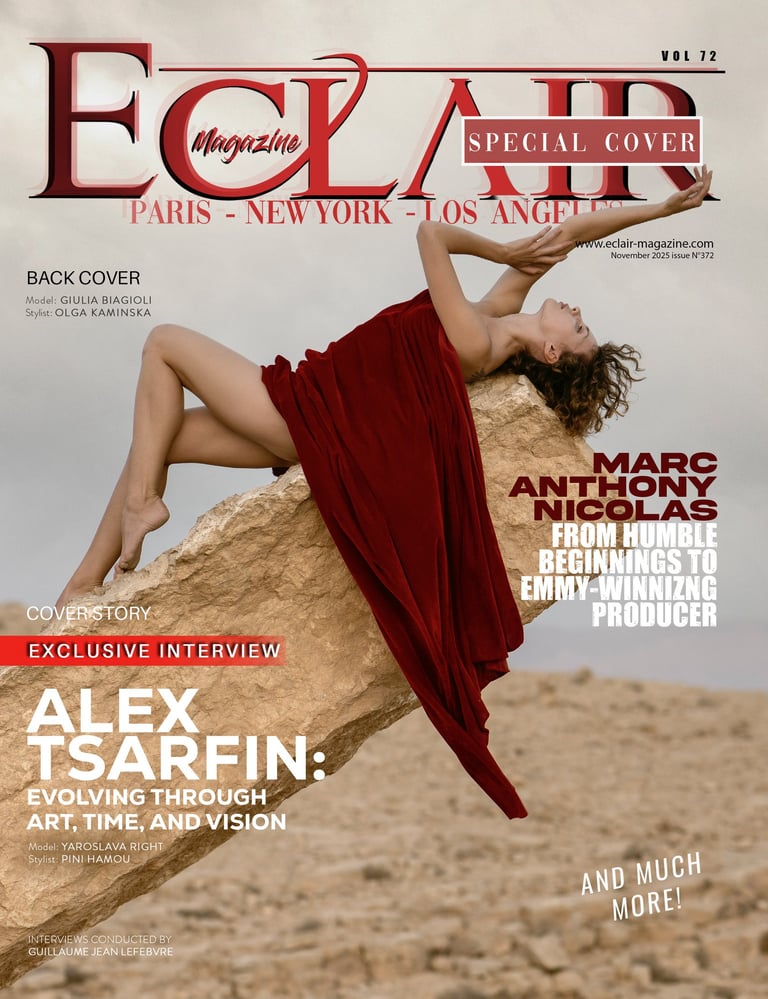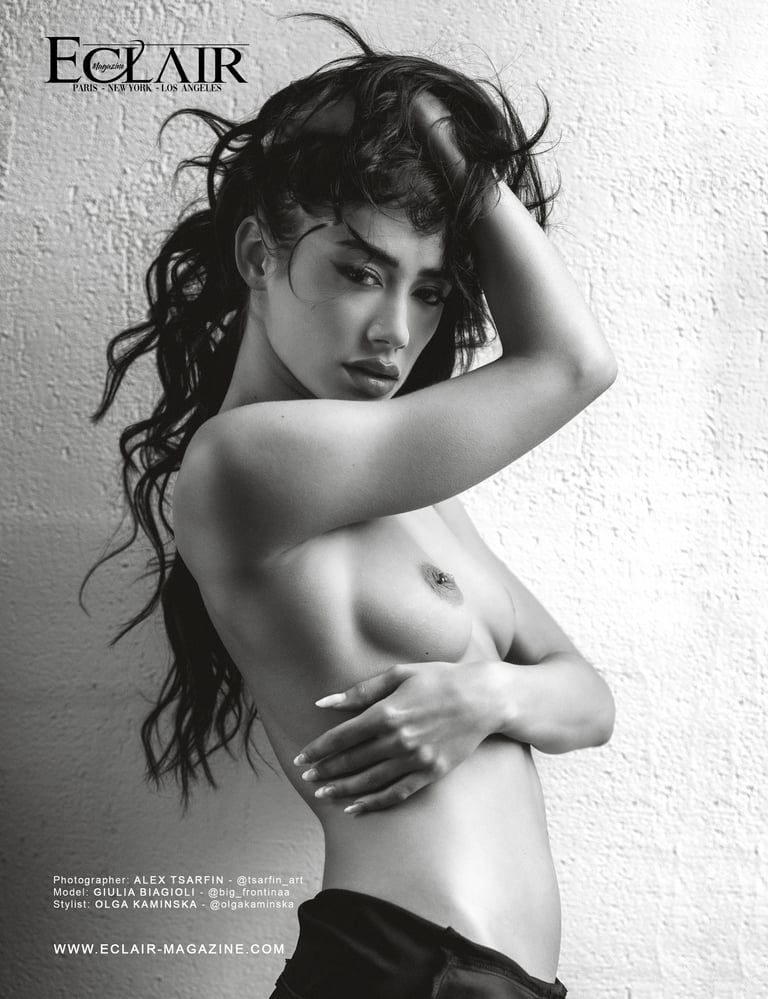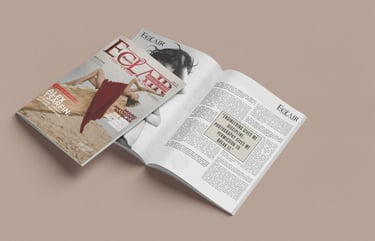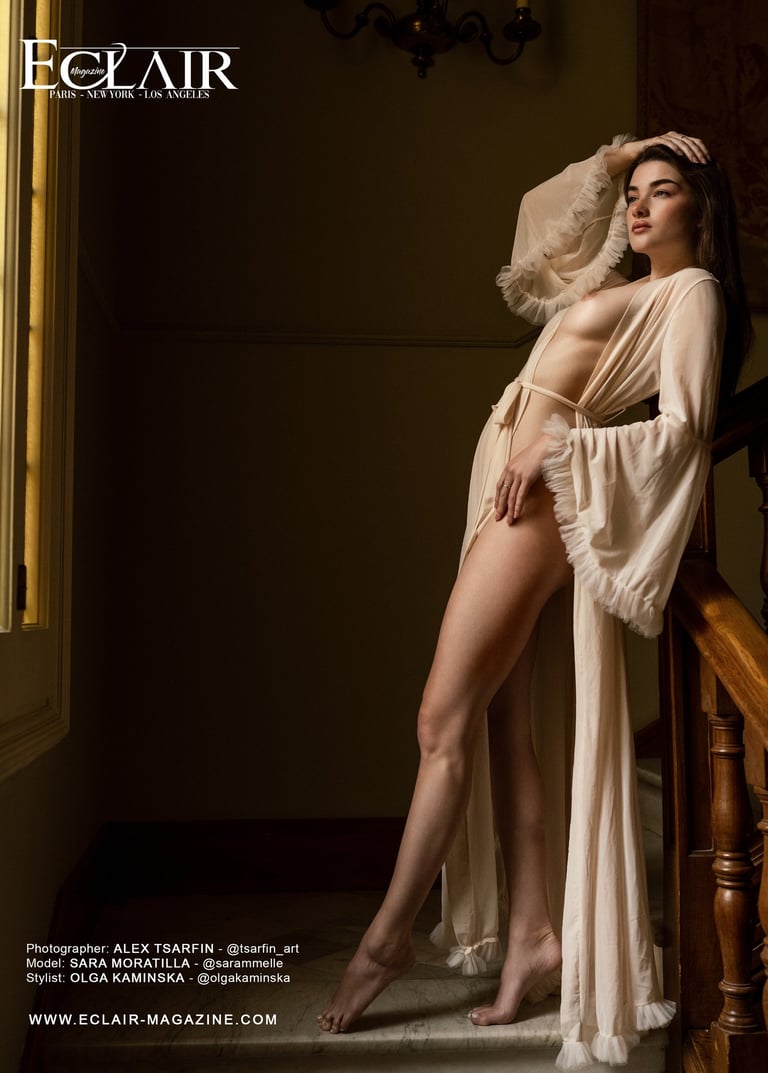EXCLUSIVE INTERVIEW
Alex Tsarfin: Evolving Through Art, Time, and Vision
Conducted by Guillaume Jean Lefebvre


1. Alex, since your last feature in Éclair Magazine, how has your artistic or professional journey evolved? Have there been new projects, exhibitions, or directions that surprised even you?
Since the last Éclair feature, my focus on the human figure has deepened. I’ve been developing new portraits and series in a mix of art studios and private residences across Europe. Alongside this studio practice, my work appeared in three group exhibitions — Corporeality (2024), Faces (2025), and Sex and Politics (2025). Stepping beyond the controlled studio pushed me to trust lived spaces and small gestures; I also reintroduced color with a measured warmth that protects skin tones. The direction feels clearer, looser, and more intimate — and I’m shaping a compact book that threads these recent series together.
2. Your previous interview revealed a deep balance between technology and art. Has your relationship with these two worlds shifted over time — do you find yourself leaning more toward one today?
You’re right — my last Éclair interview leaned on my engineering roots and how that system’s mindset shaped my photography. Today that influence is quieter. The technical rigor is still there — reliable color, clean files, disciplined workflow — but it’s no longer the driver. I’m led far more by artists than by algorithms. I find myself reaching for classical composition and painterly light — thinking in lines and tensions closer to Ingres or Delacroix than to schematics. Intuition, posture, and mood come first; tools follow. In practice, that means simpler setups, softer color, and portraits that breathe. Engineering keeps the craft consistent; the art — and the artists — set the tone.
3. The world of photography has changed dramatically in recent years, especially with AI and digital tools. How do you view this transformation — as an opportunity for creativity or a threat to artistic authenticity?
I see it mostly as an opportunity — if it stays a tool. AI and new digital tech are great for workflow, color management, and keeping prints consistent. But I don’t use them to invent people or moments. For portraits, authenticity comes from time with the sitter, not synthetic detail. My edits stay simple and transparent — basic Lightroom adjustments, color corrections in Photoshop, no composites. In short: tech helps me deliver the work; it doesn’t author it.
4. You’ve always valued authenticity in your work. How do you continue to challenge yourself creatively while maintaining that personal integrity in a world that often rewards trends over depth?
I keep the process slow and human. That’s the anchor. The challenge comes from shifting the environment, not the values: new faces, new spaces, new light — while keeping everything real and unforced. I avoid trends by letting the sitter set the rhythm and by staying loyal to classical composition and honest color. Integrity, for me, is choosing depth even when the market celebrates shortcuts. I’d rather make a quieter portrait that feels lived-in than chase a style built for algorithms. If the connection in the room is real, the work stays grounded — no matter what the industry rewards that week.
5. In your early career, you found beauty in precision and engineering. Do you see parallels between the discipline of engineering and the intuition of photography today?
Yes, but the balance has changed. In the beginning, engineering was my foundation — precision, structure, clean problem-solving. Those habits still help — they keep my workflow consistent, my color accurate, my prints reliable. But they’re no longer the engine behind the images. Today the parallels feel softer. Engineering gives me discipline; photography gives me permission to break it. I still think in terms of structure and clarity, but intuition leads — how someone holds their breath, how light touches skin, how a moment settles. The two worlds aren’t equal anymore, but they still speak to each other: one keeps the craft steady, the other keeps the work alive.
Since his first appearance in Éclair Magazine, Alex Tsarfin has continued to carve a singular path — one where discipline meets intuition, and where the human presence remains the central compass of his vision. Known for portraits that balance classical composition with quiet emotional tension, Tsarfin moves through the contemporary art world with a rare sense of intention: slow, deliberate, and deeply human.
Over the past two years, his artistic practice has grown both inward and outward. He has expanded his work across Europe, developing new series in studios and private spaces that allow his sitters to unfold naturally in front of the lens. This shift toward lived environments — bedrooms, ateliers, sunlit corners of personal homes — has infused his images with warmth, softness, and a subtle volatility that mirrors real life.
His presence in three group exhibitions, Corporeality (2024), Faces (2025), and Sex and Politics (2025), marked a decisive moment. These showcases placed his work in conversation with diverse artistic voices, revealing how quietly powerful his portraits are when viewed alongside more dramatic or experimental pieces. In these settings, Tsarfin’s images stand out not for their noise, but for their honesty.
Although he began his creative life grounded in engineering, Tsarfin now works from a place shaped less by technical calculation and more by artistic instinct. His current influences draw from classical painters and sculptors, from the whisper of light on skin, from a sitter’s posture and breath rather than the rigidity of structure. Engineering still guides the craftsmanship — the clarity, the workflow, the reliability of color — but the emotional direction has shifted entirely toward the poetic.
Themes of vulnerability, quiet strength, and the intimate tension between the two now define his evolving visual language. His portraits no longer aim to construct a moment but to reveal it, often with a softness that carries the weight of lived histories. Whether captured in a simple studio setup or a textured interior, his subjects appear contemplative, grounded, and profoundly real.
Tsarfin’s work has slowly moved from private passion to public recognition. Exhibitions in Paris and Arles, collaborations with Singulart, and the international reception of pieces like People of the Earth and Seraphic Ascension have opened new doors — without compromising the deeply personal nature of his practice. For him, sharing the work is meaningful, but creating it remains an intimate, solitary journey.
Travel, challenges, and a changing sense of self have further refined his perspective. These experiences have taught him to slow down, to observe before capturing, and to approach each sitter with humility and patience. The result is an artistic voice that grows quieter with time — yet more truthful, more grounded, and more resonant.Today, as he prepares a new book gathering his recent series, one phrase guides his next chapter: “a quieter kind of truth.” It encapsulates everything he has moved toward — portraits shaped by presence rather than performance, by depth rather than spectacle.What follows is the full conversation with Alex Tsarfin, offering deeper insight into the reflections, inspirations, and experiences shaping his work today.


INTERVIEW
6. Many of your past works were inspired by the human spirit and natural beauty. Are there new emotional or thematic elements you’ve begun to explore through your lens in recent years?
Lately I’ve been drawn to themes that sit closer to the skin — vulnerability, power, and the unspoken space between the two. The human spirit is still at the center, but the tone has shifted from pure softness to something more layered: tenderness with tension, beauty with a bit of friction. Working in real interiors and private spaces also changed the emotional palette. There’s more atmosphere now — quiet politics, lived intimacy, the trace of someone’s history in how they stand or look back at the camera. I’m exploring those small, charged moments where a portrait stops being just representation and becomes a kind of confession.
7. Looking back at your early photographs — from the “Gates to Delirium” era to now — what do you feel has changed most in your visual language or storytelling style?
What’s changed most is the tone. Gates to Delirium was sharp, dramatic, almost architectural — the tension was built into the poses and the structure around the bodies. Today the work is quieter and more intimate. The storytelling comes from mood, color, and how someone settles into space. It’s less about constructing tension and more about letting a moment unfold. The images feel warmer, more human, and more painterly than before.
8. You once described photography as a personal passion rather than a commercial pursuit. Have you ever been tempted to turn it into something more public, or do you still prefer to keep it as a private form of artistic expression?
I’ve opened the door a little more in recent years, but the core of it is still personal to me. The exhibitions in Paris and Arles changed things — People of the Earth in Corporeality, Portrait of a Chinese Girl in Faces, and Seraphic Ascension in Sex and Politics. Showing work in those contexts, especially alongside Paris Photo, made me realize that the images resonate beyond my own circle. And my collaboration with Singulart has shown me that collectors value the same quiet, introspective atmosphere I build for myself. But even with all of that, I still treat photography as an intimate practice first. The public side — exhibitions, interviews, sales — is a natural extension, not a motivation. I’m happy to share the work when it finds the right context, but the act of making it remains private, slow, and personal. The balance feels right: the work can travel, but the process stays mine.
9. The creative process often mirrors personal growth. How have your life experiences — perhaps travels, challenges, or reflections — influenced your way of seeing and capturing the world today?
Travel and experience have reshaped the way I look at people and the world — mostly by slowing me down. Spending time in places far from my own background, like the communities behind People of the Earth, taught me to approach portraits with more patience and humility. Those moments changed how I work: I listen more, watch more, and let people settle into themselves before I ever lift the camera. The past few years also brought their own challenges and pauses, and that quiet space made its way into the images. The newer portraits — whether a simple studio study or a large staging like Seraphic Ascension — carry more calm, more attention to small gestures, more honesty. In short, life pushed me toward a softer, more observant way of working. The photographs are still composed and intentional, but they come from a deeper place now — less about impressing the eye, more about understanding the person in front of me.
10. Finally, if you could define the next chapter of your artistic journey in one phrase, what would it be — and why does that phrase capture who you are now?
“A quieter kind of truth.” That’s the direction I feel myself moving toward. After all the travel, the exhibitions, and the different worlds I’ve stepped into, my work keeps circling back to simple, honest moments — the kind you don’t need to dress up or force. It’s less about big gestures now and more about presence, about seeing someone as they are. That phrase feels right because it reflects where I am personally too: calmer, more focused, and more interested in depth than noise.




Photographer: ALEX TSARFIN - @tsarfin_art
Models: YAROSLAVA RIGHT - @yaroslavaright
IRENA BOKO - @irenaboko
VALERIA GUREVICH - @valeria_gurevich
ALMOG ROZANO - @almogrozano
ZUZANNA KIDZIAK - @zuza_balerina
MAJON V/D SCHOT - @myownbymajon
ROZI VITEBSKY - @rozivit
GIULIA BIAGIOLI - @big_frontinaa
SARA MORATILLA - @sarammelle
Stylists: PINI HAMOU - @pini_hamou
OLGA KAMINSKA - @olgakaminska
YOSSI ADAM - @yossi.adam


Quality, not quantity
We have made quality our habit. It’s not something that we just strive for – we live by this principle every day.
